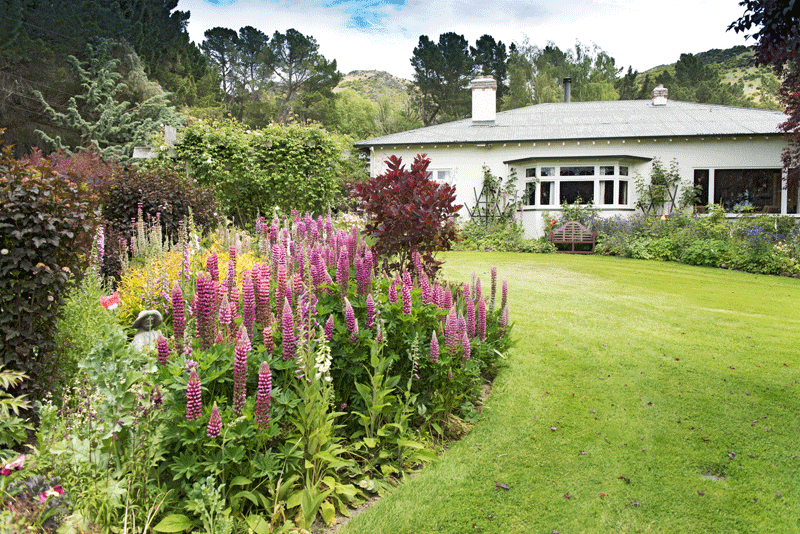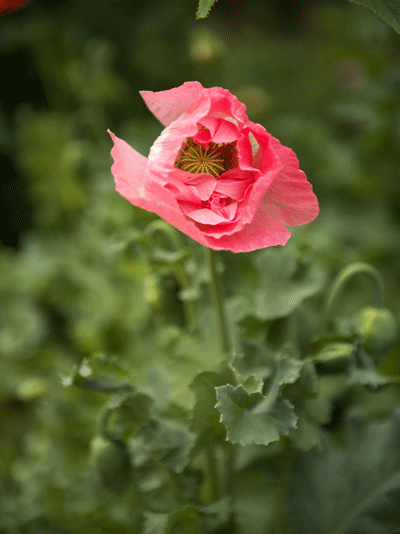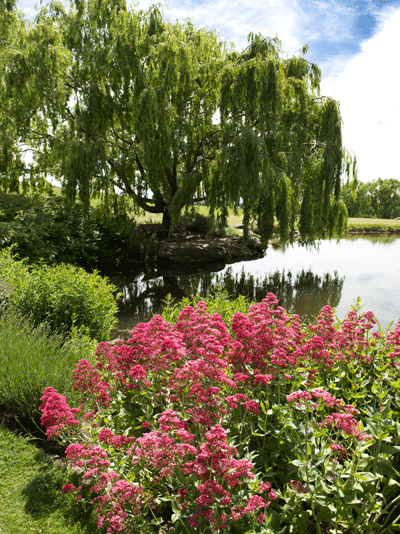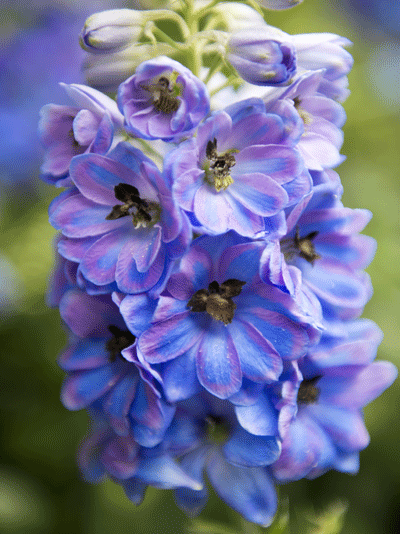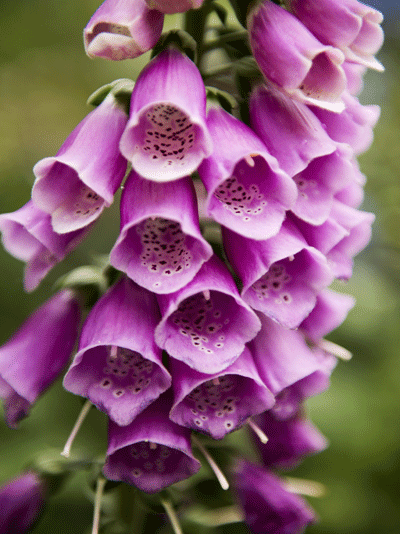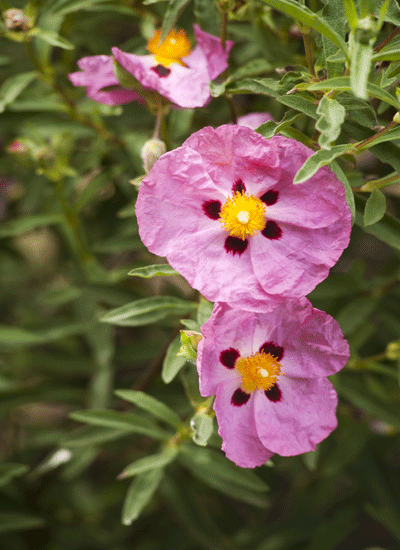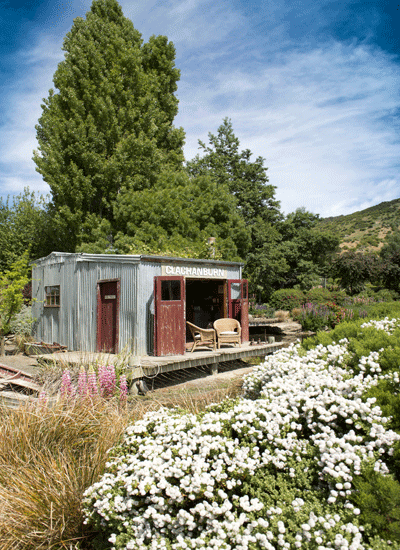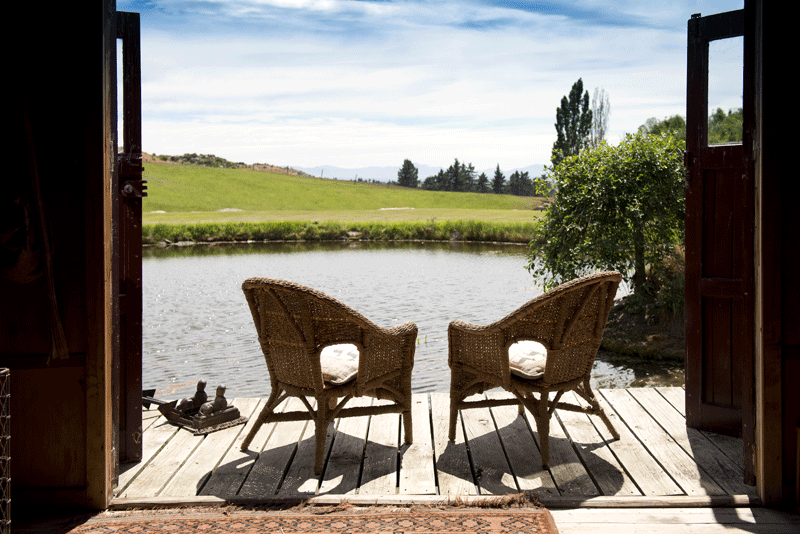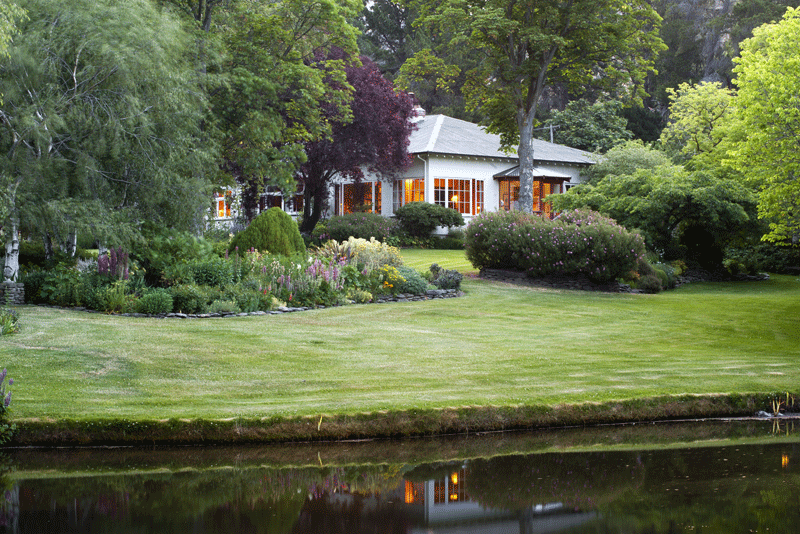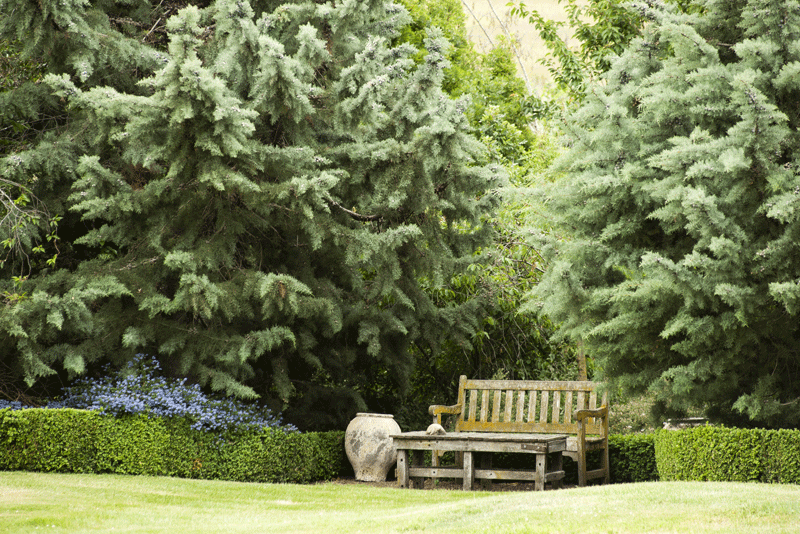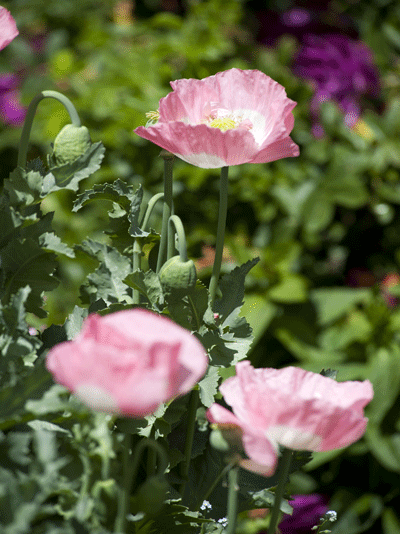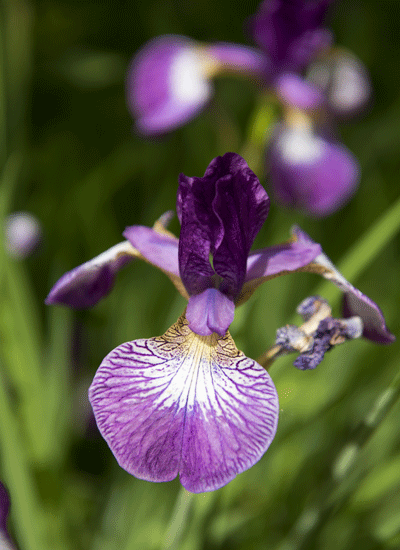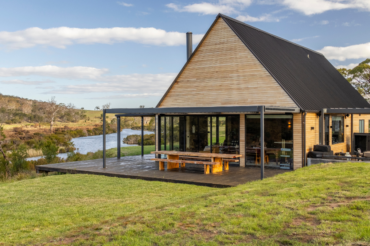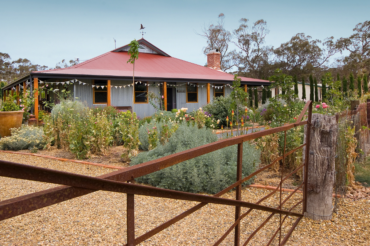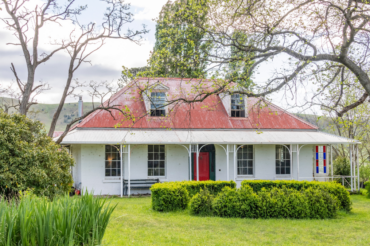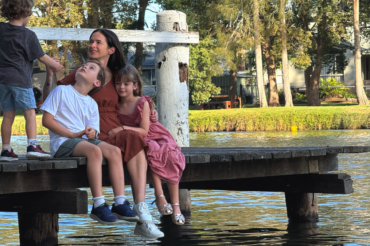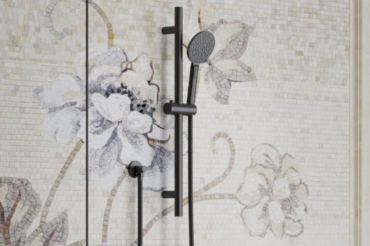Every garden has a spot that draws you in, that catches your attention, sticks in your memory. Whether intentional by design or not is beside the point. Clachanburn Garden in New Zealand’s Central Otago is no different. The magic place here is below the homestead, where a gnarly old box elder opens its arthritic arms over a small patch of lawn, creating an enchanted shady spot. A little garden table and two chairs confirm this rather special position within the realms of the garden. Here, the garden is at its lushest, shaded by the box and a tall poplar, trees as opposite in shape as yin and yang. A small grown-in creek murmurs through this idyllic location. Leafy groundcovers surround large granite rocks. There is a Zen-like peacefulness here with English black birds and little native birds creating ambient sound. But it is especially here that the stark contrast between the garden and the outside world hits home.
Driving to Clachanburn is driving through New Zealand’s outback. It is rain-shadow country, also known as the Maniototo. Agriculture is possible through irrigation but away from the fields, it is a monochrome, treeless landscape framed by bare mountains. How is it possible then to establish a garden of such diversity and lushness, an oasis within a region of such harshness? Clachanburn is considered the garden with the most extreme climate in New Zealand and because of that is rewarded with the status of a Garden of National Significance. The real treasure, however, is its creator: Jane Falconer. If we could classify humans like cyclones on a scale from one to five, the farmer’s widow, although getting on in life, would be at least a category four. Just following her around the garden leaves you breathless.
Jane grew up in Middlemarch, which is more or less on the other side of the hills that border Clachanburn. “When I first came here in 1979 as a young bride, the Maniototo was dryland farmed. No water. And by December, the flats would be brown,’’ she recalls. ‘‘I thought I was going to have a gorgeous garden like my mother in about five minutes flat, but youth is innocent. We are twice the altitude up here and half the rainfall. The homestead is 1600 feet (487 metres) and natural rainfall is 12 to 14 inches (305 to 356 millimetres).” When she and her late husband, Charles, moved into Clachanburn homestead, there was a small garden around the house. It formed the nucleus from which the garden grew. “I suppose then the garden would be not more than one and a half acres,” Jane recalls. “Now it is four and a half.”
Although Jane began looking at the opportunities that lay ahead almost immediately after her arrival, a solution to the major obstacle — a lack of water — wasn’t found until 1984, when the Maniototo Irrigation Scheme was commissioned. She got lucky. The main water race was built on the western side of the mountains, her side. All they had to do was pump the water up to the foothills and then gravity would feed it back. “So the water came in ’84,” Jane says. “In ’85, our two children went to boarding school. One on Monday and one on Wednesday. On Thursday morning, I sat on the kitchen table and I said to Charles, ‘my nest is empty, I’m going to go stark raving mad and I think the best thing you can do is to move this fence, because I’m going to garden’. So he moved the fence and subsequently moved it six times.”
From then on, Jane was unstoppable. “I sort of had a vision probably based on my childhood home,” she recalls. “And both [the sites] funnily enough lie in the southwest corner of the basin, both are elevated sites, both have a backdrop of a mountain range, both share the northerly aspect of the Kakanui Mountains … It’s sort of what I knew.” She felt that the homestead, surrounded by a small garden, would be out of proportion. “I wanted to have nice lawns that balance the house,” she says. By making the garden bigger and flowing, she achieved that balance. Although she had an overall idea of how she wanted the garden, her project took on a direction of its own. “If you ask me if I envisaged the garden as it is today, the answer would be no,” Jane says. “The garden and I grew together.”
Since her husband moved the first fence, she has extended the garden five times. Her first extension, stage two (if you mark the existing garden around the homestead as stage one), focused around Stony Creek. This was followed by stage three with the tennis court, the more formal rose garden, the long shrubbery border, the conifer and heather bank and the top pond. The establishment of the orchard at the top end of the garden followed near the quaint cottage she rents out to visitors. With stage four finished, she then put her energy into stage five and established the bottom pond with the boat shed. The final stage was the donkey paddock.
I start my exploration at the picturesque cottage. Just below is the orchard. Pear, apple, plum, peach, apricot and quince trees stand in a knee-deep meadow of buttercups and dandelions, loaded with green, early-summer fruit. It reminds me of Bavarian farm orchards. Through the orchard runs the little creek. From here, one of the most important features, and one of the secrets to Jane’s success, is visible: a long barrier of Pinus radiata. “Our pine trees that sort of go behind the homestead give us initial shelter and inside that, we’ve got quite a microclimate,” Jane says. This protective wall of mature trees sits at the highest point of the garden. From there, it gently flows down to the ponds. With her planted trees now mature, or at least of reasonable size, they begin to shelter plants that would have difficulty surviving in the region’s harsh climate.
Although most credit for Clachanburn garden has to go to Jane, the heavy lifting was done by others. “Along the way, I had six third-year-degree landscape boys from Holland,’’ she admits. ‘‘That terraced stone work over at the nuttery, one boy did that in four months. Then the courtyard, the pétanque court and the stone work around the cottage were done. They were fantastic. I had one girl who popped the map onto an AutoCAD program and did a plant inventory.” And, of course, there are her “farm men”, her late husband, Charles, and son, John. “Charles made the ponds, moving fences and doing mechanical things,” Jane recalls. “But they are not artistic. They are big-picture boys. These Dutch boys were arty farty, you know, we were on the same wavelength. They were fantastic.”
Below the orchards, I have a choice: follow the creek down to the box elder and eventually reach the first pond or, at the little bridge, veer left and follow the long shrubbery border to the tennis court, where roses adorn the high fence surrounding it. This is followed by the rose garden. Here, the garden is the most English, with tightly trimmed box hedges, a garden bench, sun dial and, of course, roses. “I think parts of this garden are English but I would like to think that parts of the garden are more New Zealand and let go a bit,” Jane says.
“There are some tussocks, the nuttery, which is quite different as I’ve let it go at the edges.” Central among the box hedges stands a cherry tree. Wherever you go in the garden, there are trees. “At our home, we had beautiful English trees,” Jane remembers. “Early on in the garden club here, one of the members said to me, ‘Jane, concentrate on trees’. So I think I have done the three-storey thing. I think it is about shapes. Trees coming down a storey to shrubs and then finally into groundcovers. It took years to look after trees here because of our harshness. You have to dig a good hole, put mulch and compost in, stake it, protect it from rabbits, possums, while trying to keep the gate shut so the sheep and deer don’t get in. So, it hasn’t been easy that garden here. This is a harsh climate with extremes — hot, dry summers, cold winters, the ponds freeze, water freezes. I have to break the ice sometimes in the creek to get water if the pipes are frozen up. I mean, it is not easy.”
As I visit in summer, the icy unforgiving days of winter seem an abstract concept. The lushness and abundance of plants in flower make the thought of bare trees and dormant plants covered in hoar frost or dusted with snow all but impossible. Especially down at the bottom pond with its fabulous boat shed. Its picturesque location; the whole set-up is cover material for a lifestyle magazine displaying a summer setting. The garden goes through the full cycle of the year with four distinct seasons. I ask Jane what her favourite season is.
She is slightly taken aback. “That’s like asking me, ‘now Jane, you have four children, which one do you love most?’” she replies. “The seasons are so very different here so you enjoy each season for what it is. Just like your kids. Certain kids have different qualities. You love them for the different qualities they’ve got. So I think the garden is a bit like that. I love different bits of the garden at different seasons because it is a little bit like an orchestra. At one stage, it’s at the height of its sound or beauty and the others are sitting in the back row lying low. And then it’s their turn. I’ve always been aware of trying to have interest in the garden 12 months of the year. This is not just a spring garden. It’s a garden for all seasons. I think in winter, the garden is quite beautiful. We admire structure and we admire the lines of the garden. I think winter is quite special. Take the grandchildren down to the boathouse, cook up some hot chocolate, have a heavenly fire, I mean winter is OK.”
Words & Photography Don Fuchs

